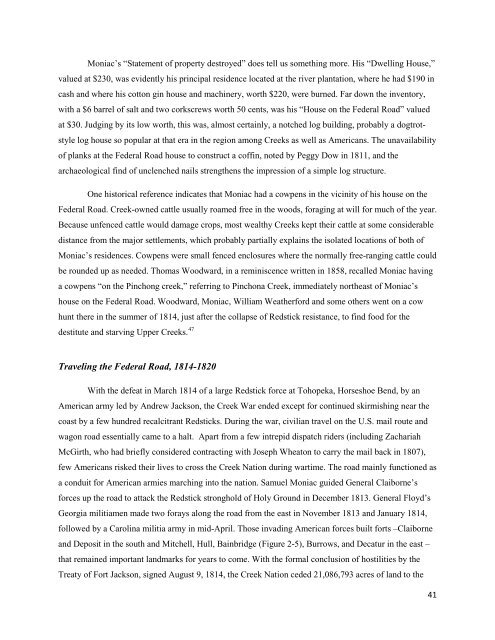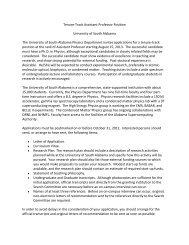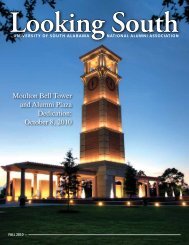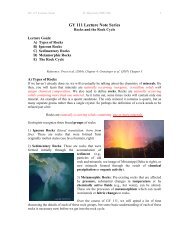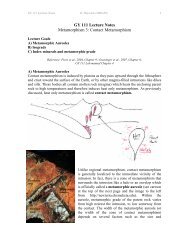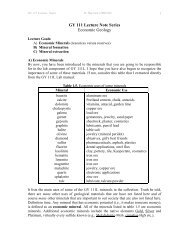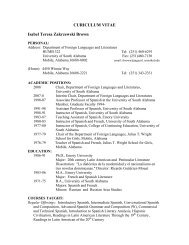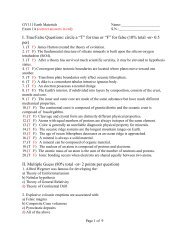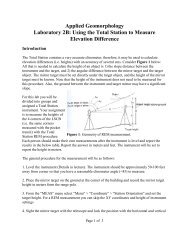Archaeological Survey of the Old Federal Road in Alabama
Archaeological Survey of the Old Federal Road in Alabama
Archaeological Survey of the Old Federal Road in Alabama
You also want an ePaper? Increase the reach of your titles
YUMPU automatically turns print PDFs into web optimized ePapers that Google loves.
Moniac’s “Statement <strong>of</strong> property destroyed” does tell us someth<strong>in</strong>g more. His “Dwell<strong>in</strong>g House,”valued at $230, was evidently his pr<strong>in</strong>cipal residence located at <strong>the</strong> river plantation, where he had $190 <strong>in</strong>cash and where his cotton g<strong>in</strong> house and mach<strong>in</strong>ery, worth $220, were burned. Far down <strong>the</strong> <strong>in</strong>ventory,with a $6 barrel <strong>of</strong> salt and two corkscrews worth 50 cents, was his “House on <strong>the</strong> <strong>Federal</strong> <strong>Road</strong>” valuedat $30. Judg<strong>in</strong>g by its low worth, this was, almost certa<strong>in</strong>ly, a notched log build<strong>in</strong>g, probably a dogtrotstylelog house so popular at that era <strong>in</strong> <strong>the</strong> region among Creeks as well as Americans. The unavailability<strong>of</strong> planks at <strong>the</strong> <strong>Federal</strong> <strong>Road</strong> house to construct a c<strong>of</strong>f<strong>in</strong>, noted by Peggy Dow <strong>in</strong> 1811, and <strong>the</strong>archaeological f<strong>in</strong>d <strong>of</strong> unclenched nails streng<strong>the</strong>ns <strong>the</strong> impression <strong>of</strong> a simple log structure.One historical reference <strong>in</strong>dicates that Moniac had a cowpens <strong>in</strong> <strong>the</strong> vic<strong>in</strong>ity <strong>of</strong> his house on <strong>the</strong><strong>Federal</strong> <strong>Road</strong>. Creek-owned cattle usually roamed free <strong>in</strong> <strong>the</strong> woods, forag<strong>in</strong>g at will for much <strong>of</strong> <strong>the</strong> year.Because unfenced cattle would damage crops, most wealthy Creeks kept <strong>the</strong>ir cattle at some considerabledistance from <strong>the</strong> major settlements, which probably partially expla<strong>in</strong>s <strong>the</strong> isolated locations <strong>of</strong> both <strong>of</strong>Moniac’s residences. Cowpens were small fenced enclosures where <strong>the</strong> normally free-rang<strong>in</strong>g cattle couldbe rounded up as needed. Thomas Woodward, <strong>in</strong> a rem<strong>in</strong>iscence written <strong>in</strong> 1858, recalled Moniac hav<strong>in</strong>ga cowpens “on <strong>the</strong> P<strong>in</strong>chong creek,” referr<strong>in</strong>g to P<strong>in</strong>chona Creek, immediately nor<strong>the</strong>ast <strong>of</strong> Moniac’shouse on <strong>the</strong> <strong>Federal</strong> <strong>Road</strong>. Woodward, Moniac, William Wea<strong>the</strong>rford and some o<strong>the</strong>rs went on a cowhunt <strong>the</strong>re <strong>in</strong> <strong>the</strong> summer <strong>of</strong> 1814, just after <strong>the</strong> collapse <strong>of</strong> Redstick resistance, to f<strong>in</strong>d food for <strong>the</strong>destitute and starv<strong>in</strong>g Upper Creeks. 47Travel<strong>in</strong>g <strong>the</strong> <strong>Federal</strong> <strong>Road</strong>, 1814-1820With <strong>the</strong> defeat <strong>in</strong> March 1814 <strong>of</strong> a large Redstick force at Tohopeka, Horseshoe Bend, by anAmerican army led by Andrew Jackson, <strong>the</strong> Creek War ended except for cont<strong>in</strong>ued skirmish<strong>in</strong>g near <strong>the</strong>coast by a few hundred recalcitrant Redsticks. Dur<strong>in</strong>g <strong>the</strong> war, civilian travel on <strong>the</strong> U.S. mail route andwagon road essentially came to a halt. Apart from a few <strong>in</strong>trepid dispatch riders (<strong>in</strong>clud<strong>in</strong>g ZachariahMcGirth, who had briefly considered contract<strong>in</strong>g with Joseph Wheaton to carry <strong>the</strong> mail back <strong>in</strong> 1807),few Americans risked <strong>the</strong>ir lives to cross <strong>the</strong> Creek Nation dur<strong>in</strong>g wartime. The road ma<strong>in</strong>ly functioned asa conduit for American armies march<strong>in</strong>g <strong>in</strong>to <strong>the</strong> nation. Samuel Moniac guided General Claiborne’sforces up <strong>the</strong> road to attack <strong>the</strong> Redstick stronghold <strong>of</strong> Holy Ground <strong>in</strong> December 1813. General Floyd’sGeorgia militiamen made two forays along <strong>the</strong> road from <strong>the</strong> east <strong>in</strong> November 1813 and January 1814,followed by a Carol<strong>in</strong>a militia army <strong>in</strong> mid-April. Those <strong>in</strong>vad<strong>in</strong>g American forces built forts –Claiborneand Deposit <strong>in</strong> <strong>the</strong> south and Mitchell, Hull, Ba<strong>in</strong>bridge (Figure 2-5), Burrows, and Decatur <strong>in</strong> <strong>the</strong> east –that rema<strong>in</strong>ed important landmarks for years to come. With <strong>the</strong> formal conclusion <strong>of</strong> hostilities by <strong>the</strong>Treaty <strong>of</strong> Fort Jackson, signed August 9, 1814, <strong>the</strong> Creek Nation ceded 21,086,793 acres <strong>of</strong> land to <strong>the</strong>41


